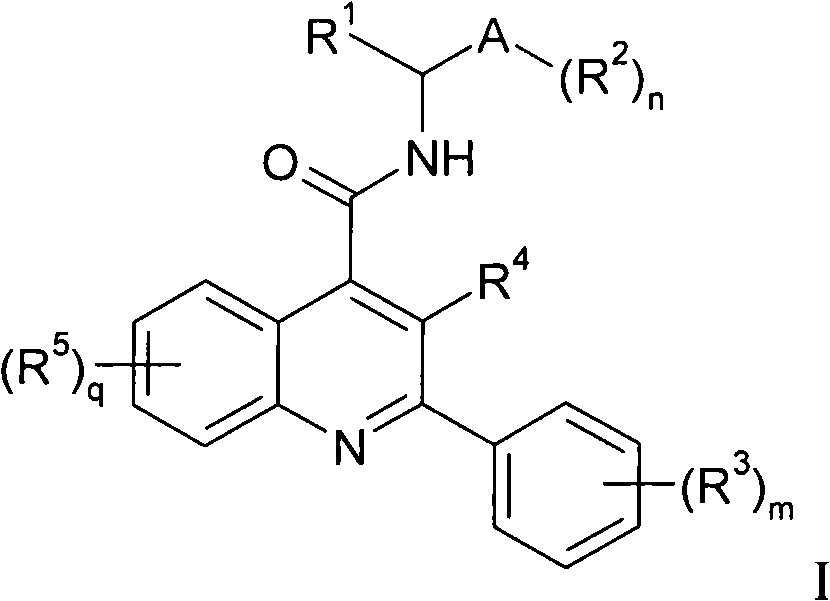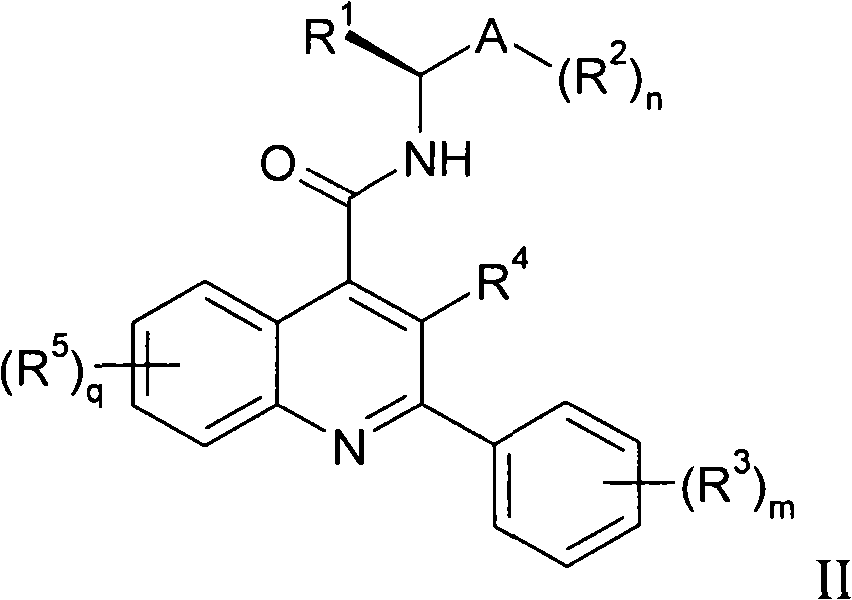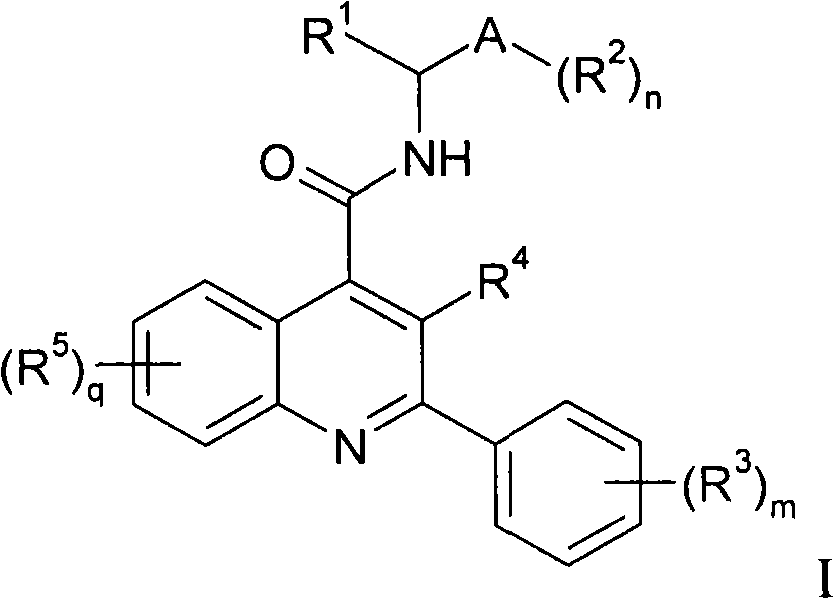Alkylnitrile quinolines, as NK-3 receptor ligands
A technology of alkyl and alkoxy, which is applied in the field of quinoline derivatives and can solve problems such as limited evaluation
- Summary
- Abstract
- Description
- Claims
- Application Information
AI Technical Summary
Problems solved by technology
Method used
Image
Examples
Embodiment 1
[0115] Example 1: N-((S)-2-cyano-1-phenylethyl)-3-hydroxy-2-phenylquinoline-4-carboxamide
[0116]
[0117] This material was prepared as follows.
[0118] (a) Benzyl ((R)-2-hydroxy-1-phenyl-ethyl)-carbamate
[0119]
[0120] A solution of (R)-2-amino-2-phenyl-ethanol (3.0 g, 21.8 mmol) and triethylamine (4.5 mL, 32.8 mmol) was dissolved in dichloromethane (60 mL). Benzyl chloroformate (3.4 mL, 24 mmol) was added thereto, and the solution was stirred at room temperature overnight. The solution was then washed with pH 7 buffer and the organic layer was concentrated (MgSO 4 ), purification by flash chromatography on silica gel, eluting with a 1-5% methanol / dichloromethane gradient, afforded the product as a white solid (3.2 g).
[0121] (b) Toluene-4-sulfonic acid (R)-2-benzyloxycarbonylamino-2-phenyl-ethyl ester
[0122]
[0123] A solution of benzyl ((R)-2-hydroxy-1-phenyl-ethyl)-carbamate (1.0 g, 3.7 mmol) and triethylamine (771 μL, 5.5 mmol) was dissolved in dichl...
Embodiment 2
[0132] Example 2.3-amino-N-[(S)-2-cyano-1-1-phenylethyl]-2-(3-fluorophenyl)quinoline-4-methyl Amides (2)
[0133]
[0134] The compound of Example 2 was prepared according to the following scheme:
[0135]
[0136] at room temperature and N 2 , to 3-amino-2-(3-fluorophenyl)quinoline-4-carboxylic acid (56.4mg, 0.2mmol), HOBT hydrate (46.3mg, 0.3mmol), 4-methylmorpholine (55μl , 0.3 mmol) in tetrahydrofuran (11 ml), EDC (57.9 mg, 0.3 mmol) was added. Then (S)-3-amino-3-phenylpropionitrile (1d) (29.2 mg, 0.2 mmol) was added and the reaction mixture was stirred at room temperature for 3.0 h. All solvent was removed in vacuo and the residue was partitioned between ethyl acetate and 10% aqueous sodium bicarbonate. The organic phase was washed with brine, dried over sodium sulfate and concentrated in vacuo. The residue was chromatographed eluting with 15-25% ethyl acetate / hexanes to afford the title compound (35 mg, 43%) as a solid. 1 H NMR (300MHz, CDCl 3 )δ3.05(d, 1...
Embodiment 3
[0137] Example 3. N-[(1S)-2-cyano-1-phenylethyl]-3-methyl-2-phenylquinoline-4-carboxamide (3)
[0138]
[0139] The compound of Example 3 was prepared according to the following scheme:
[0140]
[0141] According to the method described for N-[(1S)-2-cyano-1-phenylethyl]-3-hydroxyl-2-phenylquinoline-4-carboxamide (1), by making (S) -3-Amino-3-phenyl-propionitrile (1d) with 3-methyl-2-phenyl-quinoline-4-carboxylic acid (instead of 3-hydroxy-2-phenyl-quinoline-4-carboxy acid) to prepare the compound. 1 H NMR (300MHz, DMSO) δ9.67(d, J=8.6Hz, 1H), 8.05(d, J=8.4Hz, 1H), 7.77(s, 1H), 7.58-7.37(m, 14H), 5.61 (s, 1H), 3.20-3.01 (m, 2H), 2.16 (s, 3H).HRMS m / z392.1733, C 26 h 21 N 3 o 2 Calculated value: 392.1763.
[0142] Table 1
[0143]
[0144]
[0145]
[0146] biological test
PUM
 Login to View More
Login to View More Abstract
Description
Claims
Application Information
 Login to View More
Login to View More - R&D
- Intellectual Property
- Life Sciences
- Materials
- Tech Scout
- Unparalleled Data Quality
- Higher Quality Content
- 60% Fewer Hallucinations
Browse by: Latest US Patents, China's latest patents, Technical Efficacy Thesaurus, Application Domain, Technology Topic, Popular Technical Reports.
© 2025 PatSnap. All rights reserved.Legal|Privacy policy|Modern Slavery Act Transparency Statement|Sitemap|About US| Contact US: help@patsnap.com



